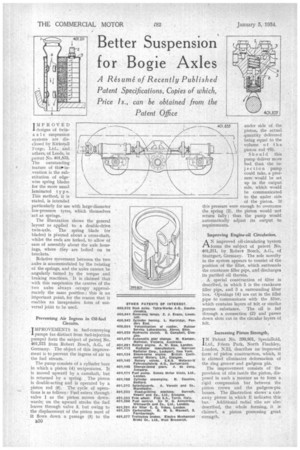Better Suspension for Bogie Axles
Page 64

If you've noticed an error in this article please click here to report it so we can fix it.
A Resume of Recently Published Patent Specifications, Copies of which, Price is., can be obtained from the Patent Office
IMPROITED designs of twina x 1 e suspension systems are disclosed by Rirkstall Forge, Ltd., and others, of Leeds, in patent No. 401,835. The outstanding feature of thigh invention is the substitution of edgewise spring blades for the more usual laminated type. This method, it is stated, is intended particularly for use with large-diameter low-pressure tyres, which themselves -act as springs.
The illustration shows the general layout as applied to a double-drive twin-axle. The spring blade (or blades) is pivoted about a cross-shaft, whilst the ends are forked, to allow of ease of assembly about the axle housings, where they are bolted on to brackets.
Relative movement between the two axles is accommodated by the twisting of the springs, and the axles cannot be angularly turned by the torque and braking reactions. It is claimed that with this suspension the centres of the two axles always occupy approximately the same position ; this is an important point, for the reason that it enables an inexpensive form of universal joint to be used.
Preventing Air Ingress in Oil-fuel Circuits.
1
. MPROVEMENTS in fuel-conveying I pumps (as distinct from fuel-injection pumps) form the subject of patent No. 401,575 from Robert Bosch, A.G., of Germany. The object of this improvement is to prevent the ingress of air to the fuel stream.
The pump consists of a cylinder bore in which a piston (4) reciprocates, It is moved upward by a camshaft, but is returned by a spring. The piston is double-acting and is operated by a piston rod (6). The cycle of operations is as follows: Fuel enters through valve 1 as the piston moves downwards; on the upward stroke the fuel leaves through valve 3, but owing to the displacement of the piston most of it flows down a passage (5) to the under side of the piston, the actual quantity delivered being equal to the volume of the piston rod -(0).
S h o-u 1 d this pump deliver more fuel than the injection pump could take, a pressure would be set up in the output side, which would be communicated to the under side of the piston. If this pressure were enough to overcome the spring (2), the piston would not return fully; thus the pump would automatically adjust its output to requirements.
Improving Engine-oil Circulation. AN improved oil-circulating 'system forms the subject of patent No. 401,211, by Robert Bosch, A.G., of Stuttgart, Germany. The sole novelty in the system appears to consist of the position of the filter, which surrounds the crankcase filler pipe, and discharges its purified oil therein.
A special construction of filter is described, in which 1 is the crankcase filler pipe, and 3 a surrounding filter box. Openings (4) are cut in the filler pipe to communicate with the filter, which contains layers of felt or similar porous substance. The oil is fed through a connection (2) and passes down slots cut in the circular layers of felt.
Increasing Piston Strength.
IN .Patent No. 399,801, Specialloid, ILtd., Friem Park, North Finchley, London, N.12, describes an improved form of piston construction, which, it is claimed eliminates deformation of the ring groove' and gudgeon pin.
The improvement consists of the provision of ribs inside the piston, disposed in such a manner as to form a rigid compression bar between the piston crown and the gudgcon-piu bosses. The illustration shows' a cutaway piston in which E indicates this
bar. Additional radial ribs are also described, the whole forming, it is claimed, a piston possessing great strength.




























































































